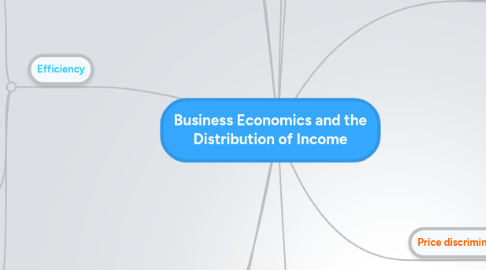
1. Perfect competition
1.1. Characteristics
1.1.1. Many buyers and sellers
1.1.2. No barriers to entry or exit
1.1.3. Identical products
1.1.4. Perfect information
1.1.5. No externalities
1.1.6. No economies of scale
1.1.7. Perfectly elastic demand
1.1.8. All firms are price takers
1.2. The shutdown condition - if variable costs cant be covered then you have no choice but to leave the industry
1.3. Unlikely to exist in real life as firms can exert control eg through advertising and asymmetric information
2. Efficiency
2.1. Static
2.1.1. New node
2.1.2. X inneficiency
2.1.2.1. What occurs when firms aren't producing on their AC, owing to organisational slack
2.1.2.2. Normally associated with monopoly
2.1.3. Productive efficiency
2.1.3.1. that which occurs when a firm produces at the lowest point of the AC curve
2.1.4. Allocative
2.1.4.1. When goods are produced in line with consumer preferences
2.1.4.2. Where price=marginal cost
2.1.5. At a given moment in time
2.2. Dynamic
2.2.1. Over a longer period of time
2.2.2. Product
2.2.3. Process
2.2.4. Perfect competition isn't dynamically efficient as there is no supernormal profit to reinvest, &perfect information allows process to be copied
2.3. Deadweight loss - the welfare loss associated with monopoly power
3. Concentrated Markets
3.1. Eg Concentration Ratio of 5=value of output of 5 largest firms/value of output of industry
3.2. Why do firms grow larger?
3.2.1. Larger market share
3.2.2. Managerial objectives
3.2.3. Profit
3.2.4. Because of economies of scale
3.3. How do firms grow larger?
3.3.1. Internal growth
3.3.1.1. Re-investment of retained profits back into the company
3.3.2. External growth
3.3.2.1. A&M
3.3.2.1.1. Integration
4. Oligopoly
4.1. When the top 5 firms in a market account for >60% of total market demand/sales
4.2. Characteristics
4.2.1. Interdependence and uncertainty about movements of other firms
4.2.2. Barriers to entry
4.2.3. Product branding
4.2.4. Non-price competition
4.2.4.1. Advertising
4.2.4.2. Loyalty cards
4.2.4.3. Increased range of services
4.2.4.4. Longer opening hours
4.2.4.5. And many, may more!
4.2.5. Kinked demand curve (price rigidity)
4.3. Collusion
4.3.1. Tacit
4.3.1.1. Barometric price leadership
4.3.2. Explicit
4.3.2.1. Cartels
4.3.3. Benefits of
4.3.3.1. Joint R&D projects
4.3.3.2. Shared use of facilities
4.3.3.3. Adoption of common standards
5. Contestable Markets
5.1. A theory which argues that it is not the number of firms that influences conduct and performance, but barriers to entry
5.2. A market is contestable when there are no barriers to entry or exit
5.3. Criticisms
5.3.1. No market has zero sunk costs
5.3.2. Do hit-and-run firms exist?
5.3.3. Existing firms will do their utmost to protect themselves
5.4. Factors that cause contestability of markets
5.4.1. Entrepreneurial zeal
5.4.2. Deregulation of markets
5.4.3. Laws against predatory behaviour from existing firms
5.4.4. Technological change
6. Costs
6.1. TC=FC+VC
6.2. Average Cost=Total Cost/Quantity
6.3. Short Run Vs Long Run
6.3.1. At least 1 factor of production is fixed in the short run
6.3.2. In the long run all factors of production are variable
6.4. Law of Diminishing Returns - if 1 factor of production is increased while other factors are held constant, output per unit of the variable factor will eventually decrease.
6.5. Specialisation reduces AVC enormously
6.6. MES occurs when all potential economies of scale have been exhausted
6.7. MR= 1/2 AR
7. Profit
7.1. Normal Profit=breaking even (where AC=AR)
7.1.1. Supernormal profit is anything in excess of normal profit
7.2. Profit maximisation occurs where Marginal Cost=Marginal revenue
7.3. Role of Profit
7.3.1. Allocation of factors of production
7.3.2. Signal for market entry
7.3.3. Promotion of innovation
7.3.4. Indicator of economic performance
7.4. principal-agent problem
7.4.1. Owners of a company (shareholders) are no longer on control of its performance
7.4.2. Managerscontrol company & may have different goals to owners
7.4.3. Due to asymmetric information
8. Price discrimination
8.1. That which occurs when firms charge different prices to different buyers for the same product
8.2. Conditions required
8.2.1. Differences in PED for each group of consumers
8.2.2. Barriers to prevent arbitrage (re-selling)
8.3. 1st degree
8.3.1. Charging the consumer the maximum they are prepared to pay (eg barter)
8.4. 2nd degree
8.4.1. Selling batches of a product at a lower price than for the same amount of the individual product
8.4.1.1. Multipack
8.4.1.2. Buy 1 get 1 free etc
8.5. 3rd degree
8.5.1. Time-related (eg peak or off-peak rail travel)
8.5.2. Geography (eg Oxford & Cambridge club)
8.5.3. Age or status (eg students or pensioners)
8.6. Reduces consumer surplus & increases producer surplus
9. Monopoly
9.1. Defined as
9.1.1. When there is only 1 firm in an industry
9.1.2. when a firm has >25% of market share (Competition Commission)
9.2. PED will be inelastic
9.3. Barriers to entry
9.3.1. High fixed costs
9.3.2. Economies of scale
9.3.3. Brand loyalty
9.3.4. Legal barriers
9.3.5. Control over factors of production
9.3.6. Control over retail outlets
9.3.7. Predatory pricing
9.4. Costs
9.4.1. Colossal supernormal profits at the expense of consumer welfare
9.4.2. Productively, allocatively and X inefficient due to lack of competition and the fact that the firm is a PRICE MAKER
9.5. Benefits
9.5.1. Potential for economies of scale therefore lower cost to the consumer than under competitive conditions
9.5.2. Natural monopoly
9.5.3. Potential for dynamic efficiency, as supernormal profits can be reinvested
10. Market structure
10.1. Factors affecting MS
10.1.1. Number of firms
10.1.2. Market share of largest firms
10.1.3. Level of vertical integration
10.1.4. Extent of product differentiation
10.1.5. Structure of buyers in an industry
10.1.6. Turnover of customers
10.2. Factors affecting pricing power
10.2.1. Costs
10.2.2. Competitors
10.2.3. Customers
10.2.4. Business objectives
